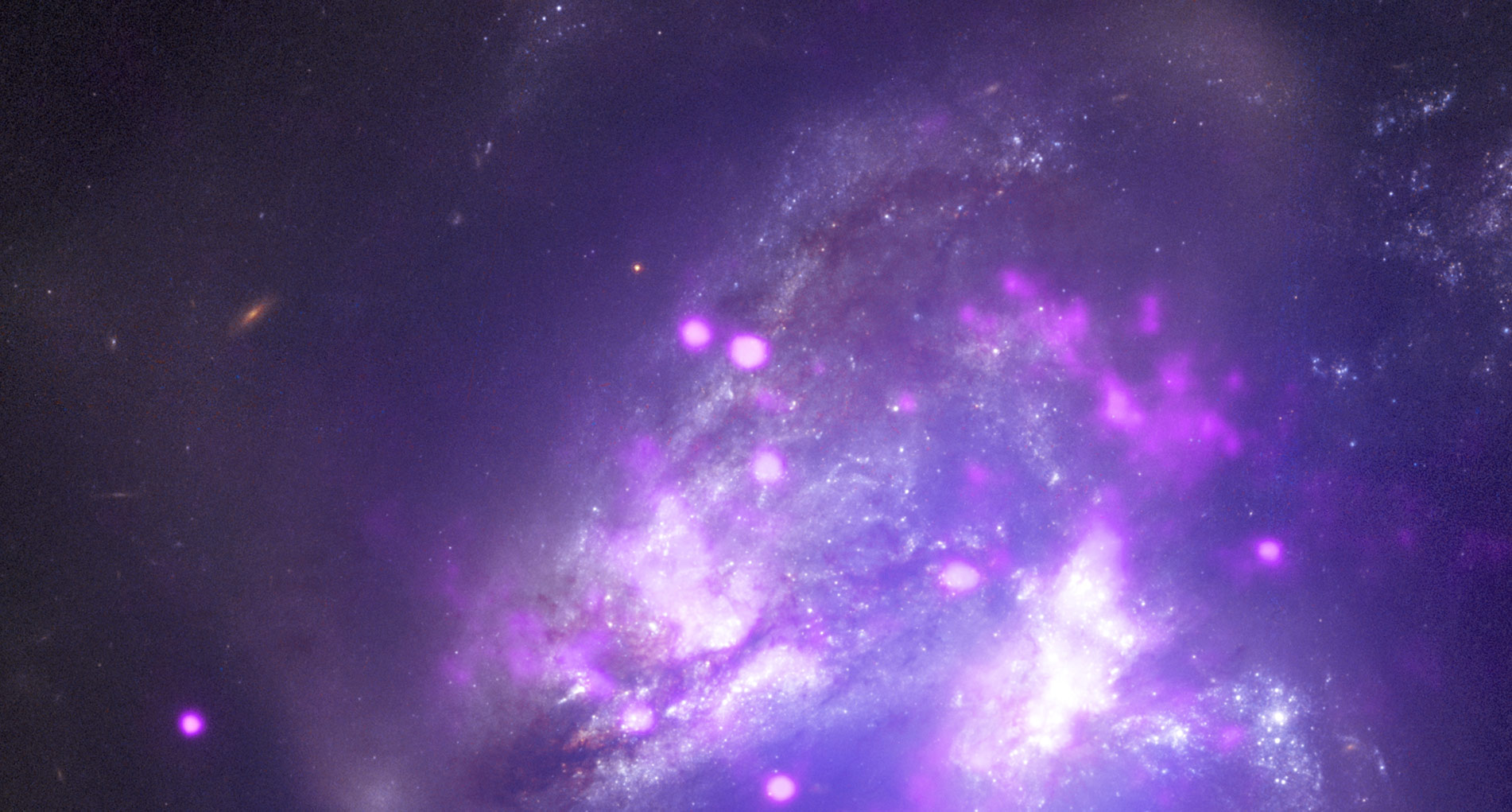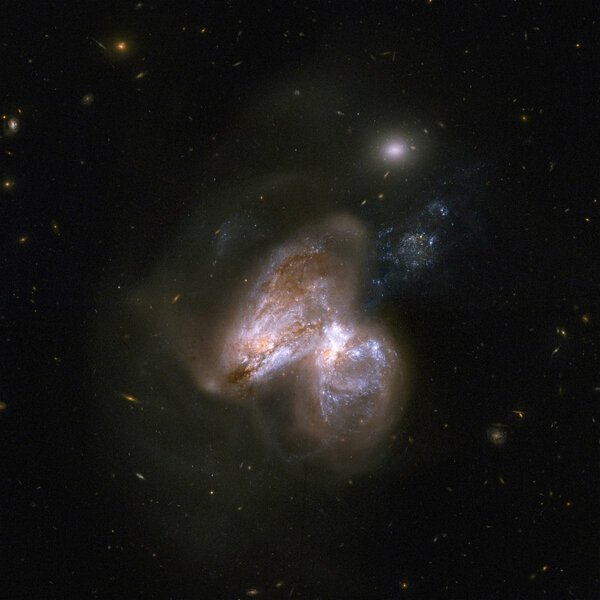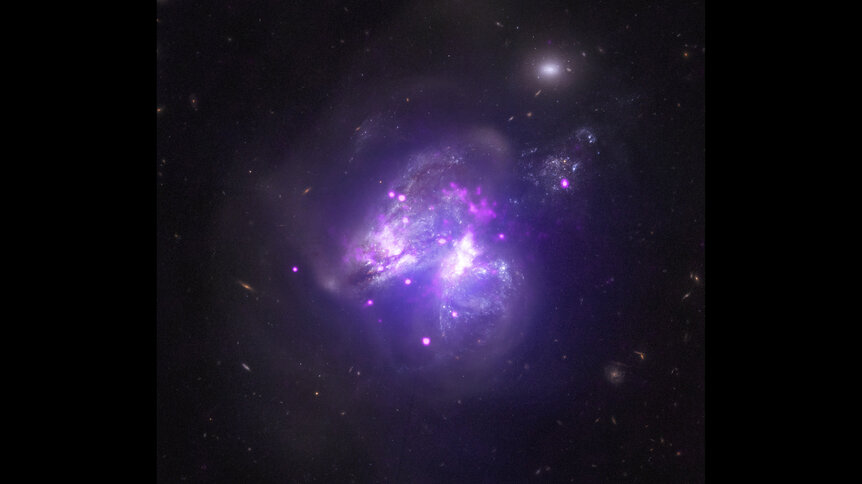Create a free profile to get unlimited access to exclusive videos, sweepstakes, and more!
Celestial fireworks pop off in a cosmic train wreck

140 million light-years from Earth lies a very strange object.
Called Arp 299, it’s a twisted, distorted mess. Arp 299 is actually two objects: a pair of galaxies that are colliding, physically slamming into each other, a cosmic train wreck played out over a hundred million years.
When two galaxies collide, the gravity of each distorts the other, stretching them out and warping their shapes. Weirdly, stars almost never actually impact each other during the collision; stars are very, very small compared to the distances between them. It would be similar to a couple of gnats accidentally hitting each other when flying around inside a football stadium.
But gas clouds are big, light-years across, and they do hit each other. This causes them to collapse, and collapsing clouds form stars. Arp 299 is seen to be forming stars at an accelerated rate, too, and has been for about 15 million years —giving a timescale for when this collision began in earnest.
[Hubble's view of the two galaxies colliding to form Arp 299. Credit: NASA/JPL-Caltech/GSFC]
Most of those newborn stars are red dwarfs, smaller and cooler and fainter than the Sun. But some are much more massive, hot and fiercely luminous. These live short lives, then explode as supernovae, leaving behind dense objects like neutron stars or black holes. If one of those massive stars had a companion star, another star orbiting it in a binary system, then the neutron star or black hole could siphon material off the companion. In the case of a black hole, it forms a super hot disk, which can be very luminous. A neutron star is no slouch either: The gravity is so fierce that a marshmallow impacting the surface would explode like a nuclear bomb! It would slam into the surface at a speed of half or more the speed of light, and that’s fast.
In either case, so much energy is generated that the system blasts out X-rays, and we call those high-mass X-ray binaries (HMXBs). If they are very luminous, they’re also called ultra-luminous X-ray sources (ULXs). A typical galaxy might have one, maybe two of these things.
New observations using the Chandra X-ray Observatory show that Arp 299 has 14 of them that are consistent with being HMXBs.
Whoa. That’s a lot.
[X-rays from Arp 299 reveal quite a few very luminous sources, including black holes slowly eating their companions. Credit: X-ray: NASA/CXC/Univ of Crete/K. Anastasopoulou et al, NASA/NuSTAR/GSFC/A. Ptak et al; Optical: NASA/STScI]
There’s a bit of a mystery here, though. The more stars a galaxy makes, the more of these systems you expect to see. For a given amount of gas forming stars, you expect lots of little stars and only a handful of massive ones. This relationship can be quantified, and used to predict how many of each kind of star you’d expect. We also can get a decent hold on how many of those stars are in binaries, and how many will form HMXBs.
When you do all those calculations for Arp 299, given how many stars it forms, the number of HMXBs you get is too low. It should have a lot more! Where are they?
The authors go through a few scenarios to explain the deficit, but most come up short. For example, the colliding galaxies are choked with dust (silicate [rocky] grains and long-chain carbon molecules), which can block light. Could that be causing the observations to miss lots of these X-ray binaries? Nope. There’s not enough dust to do it.
Other explanations fare no better. But there may be a way out: The total energy emitted by these sources in Arp 299 is about what you’d expect if the number of HMXBs were a lot higher. The authors postulate that there actually is no deficit, and Arp 299 has the number of these systems you expect, it’s just that a lot of them are forming in gas clouds that are too small to be resolved in the Chandra observations. In other words, a small region of space might have several HMXBs, but they’re so closely packed together that from our vast distance we see them as one source.
It would be like sitting down in the back of a concert hall and seeing only 10 musicians on stage. The concert starts, and to your surprise the noise level is equal to a full orchestra! If you get up and move to a closer seat, you’ll see that what you thought was 10 musicians is actually 60, but they were sitting in clumps so close together you couldn’t see all the individual players.
Arp 299 actually has quite a few other sources of X-rays. As I wrote in an article last year, one of the two galaxies in the collision has a supermassive black hole in its core that’s actively eating material, and it’s emitting a decent amount of X-rays (the other galaxy may have such an active nucleus as well, but it’s not certain). There’s also a huge halo of hot gas surrounding the pair, heated by the winds from massive stars being born there, and possibly too from stars that have exploded in the past few million years.
As I said, colliding galaxies are a mess. But then, when you take a couple of ridiculously huge galaxies packed with billions of stars and gas clouds and whack them into each other at a couple of hundred kilometers per second, you expect to see fireworks.
















